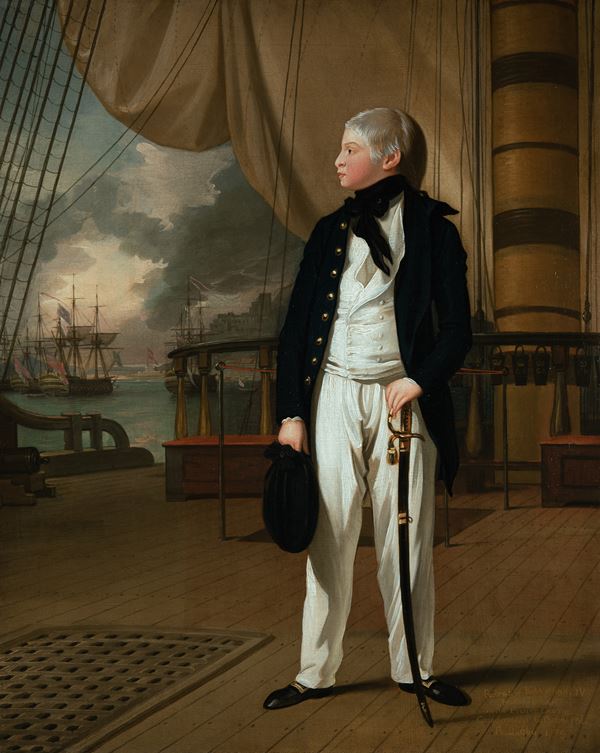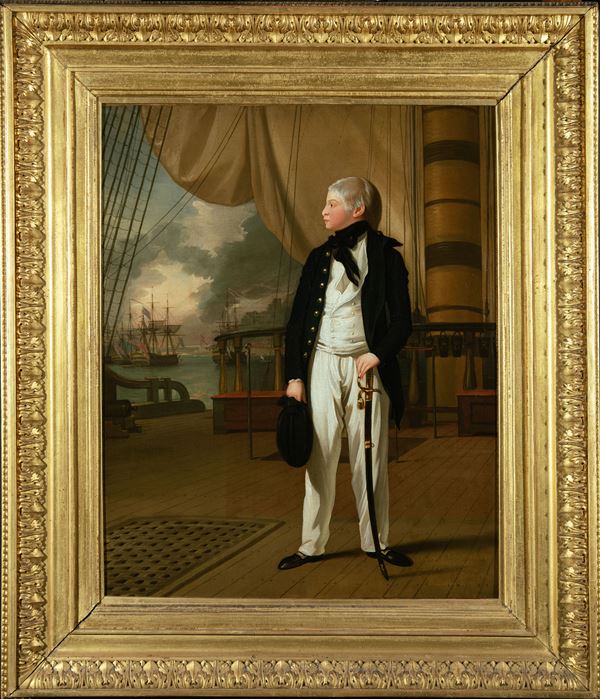Benjamin West (1738 - 1820)
Prince William as a Midshipman
Oil on canvas
21.00 x 17.00 inches (53.34 x 43.18 cm)
Painted in 1779
Inscribed, lower right: Portrait of K. William IV Midshipman on the Prince George commanded By Admiral R. Digby 1779
Inscribed on a label, verso: Portrait of King William IV as a Midshipman, when he joined Admiral the Hon.ble Robert Digby's ship the Prince George June 1779 (label torn) ..en to Admiral Digby by King Geo. III.
Provenance:
Commissioned by the sitter's father, King George III and given by him to his son's commanding office, Admiral Robert Digby (1732-1815);
By descent to his nephew, Admiral Sir Henry Digby (1770–1842);
By descent to his son, Edward Digby, 9th Baron Digby (1809-1889);
Thence by descent to Lord Digby, Minterne House
Sale, London, July 7, 2021, lot 48
Exhibition:
London, Sotheby’s, Rule Britania, 1986, no. 74
Literature:
H. von Erffa and A. Staley, The Paintings of Benjamin West, New Haven and London 1986, p. 476, no. 569 (as ‘location unknown’, reproduced from the Bartolozzi and Sandby aquatint engraving).
On the quarterdeck of the 90-gun flagship HMS Prince George[1], Prince William, the future King of England, enjoys a private moment. Masterly staged, intimate in scale and painted with finesse, William is framed by the main mast and rigging, the sail pulled back to show the fleet at anchor under a cloud filled sky. The distant harbor may be Gibraltar, defended by the British against the allied Spanish and French forces. William wears the midshipman’s uniform of a blue jacket, white waistcoat and trousers, which catch the light and evening shadows.
The third son of King George III, William’s enlistment in the Royal Navy in 1779 met with public approval. Poems and ballads were dedicated to the ‘Naval Prince’, though his father insisted that “the young man goes as a sailor, and as such, I add again, no marks of distinction are to be shown unto him.”[2] An inscription and label identify the painting as a gift from the King to William’s commanding officer, Admiral Robert Digby (1732-1815), in whose family the painting remained until recently. An engraving after the painting published in 1782 promoted the image of the royal family during the American Revolutionary War.
For this gift, George III turned to his favorite painter, Benjamin West. Several years earlier, West painted Prince William with his younger brother Prince Edward (1778; Buckingham Palace), in a life size double portrait, one of a series of George III and Queen Charlotte’s growing family.[3] While Gainsborough, Ramsay and Zoffany also received portrait commissions, West enjoyed the largest share of royal patronage, completing 60 paintings over his long and successful career. He described George III “as the best friend I ever had in my life.”[4]
Born in 1738 in Springfield, near Philadelphia, West was recognized as a prodigy and enjoyed the support of important clergy and educators who financed three years of study in Rome and other Italian cities with the expectation that he would return to the Colonies as a portraitist.[5] Known as the American Raphael, West’s ambition to become a history painter grew under the influence of Anton Mengs, Pompeo Batoni and Gavin Hamilton. Arriving in London in 1763 and marrying his American fiancée Betsy the following year, West stayed for 57 years.
After painting Neo-Classical works such as the Agrippina Landing with the Ashes of Germanicus (1768; Yale University Art Gallery), West updated British and American history painting by depicting recent events such as the Death of General Wolfe (1770; National Gallery of Canada) and William Penn’s Treaty with the Indians (1771-72; Pennsylvania Academy of Fine Arts). Soon afterwards, George III, eager to establish a school of British history painting that emphasized ancient, morally ennobling virtues, appointed West Historical Painter to the King with an annual stipend of £1,000.
Well entrenched and receptive to changing taste, West decorated Windsor Castle with massive scenes from Medieval British history and the bible. Critics and collectors preferred his small sketches to these enormous paintings and by the end of the century, with the King’s health and mental faculties in decline and the ascendancy of George IV, West was out of favor. West’s royal stipend continued to 1811 and he found private clients like William Beckford at Fonthill Abbey. In 1792, West succeeded Joshua Reynolds as the second president of the Royal Academy of Arts, an organization he joined as a founding member in 1768. With brief interruption, West served as president until 1820, when Sir Thomas Lawrence took over. West taught three generations of visiting American artists including Gilbert Stuart and Charles Wilson Peale and encouraged and competed with his fellow expatriate John Singleton Copley.[6]
After the Treaty of Amiens, West, like many English artists, travelled to Paris, where he was introduced to Napoleon. He exhibited his Death on a Pale Horse (1796; Detroit Institute of Arts), an emotionally charged Romantic subject, at the Salon of 1802.[7] West was the first American born artist with an international reputation. His double portrait of Princes George and Frederick entered the collection of Catherine II (1778; Hermitage).[8]
Like other midshipmen – apprentice officers drawn from the peerage and landed gentry – Prince William served six years at sea before taking the exam for Lieutenant. As the sole British royal to set foot in New York, William and Admiral Digby were the subject of a foiled kidnapping plot approved by George Washington. A 1785 account called the prince “Spoilt, temperamental and barely experienced enough to stand watch… He exhibited a foul mouth and a strong head with a vast repertoire of dirty stories.”[9] Nonetheless, Prince William, who was friendly with Lord Horatio Nelson when stationed in the Caribbean, served in the Royal Navy until 1797. In addition to fathering 10 illegitimate children with an Irish actress and petitioning his father and Parliament to alleviate his debts, he was appointed Lord High Admiral in 1827. With the death without issue of his older brother George IV in 1830, Prince William became King William IV, the ‘Sailor King’.
West painted the work in 1781 during the American Revolutionary War, balancing his support of American independence with a close friendship with George III. Enveloped in twilight, Prince William combines inborn pride, national purpose and the hesitancy and gentleness of youth.
[1] HMS Prince George was launched on August 31, 1772 at Chatham and broken up in 1839
[2] S.A. Cavell, A Social History of Midshipmen and Quarterdeck Boys in the Royal Navy, 1761-1831, 2010, pp. 150-170
[3] Oliver Millar, The Later Georgian Pictures in the Royal Collection, 1969, Cat. No. 1144, Pl. 111
[4] Helmut von Erffa and Allen Staley, The Paintings of Benjamin West, 1986, Preface, p. X
[5] Benjamin Franklin was godfather to West’s second son born in 1772
[6] Copley painted Midshipman Augustus Brine, in 1782. A. Staley, 2021, Copley and West in England 1775-1815.
[7] Von Erffa and Staley, Cat. 403, Detroit Institute of Arts.
[8] The Hermitage, English Art, 1979, Pl. 130; Von Erffa and Staley, Cat. 565.
[9] S.A. Cavell, p. 158, 162.








